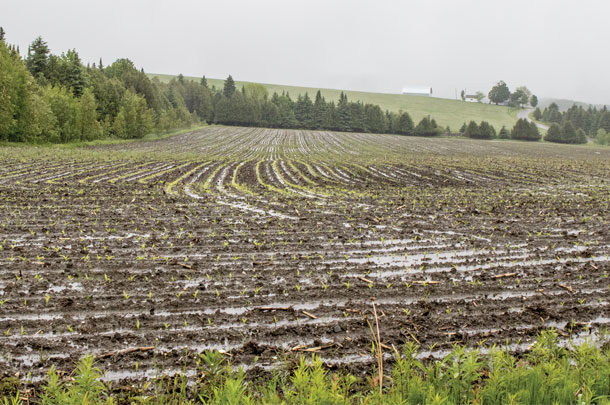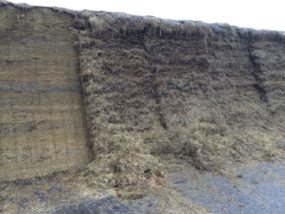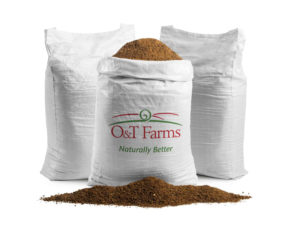The amount of rainfall and timing throughout the growing season plays a key role in corn yield and quality.
Growing conditions (especially moisture) are a major source of the nutritional variability seen within hybrids across years and locations.
Researchers at the University of Illinois attribute 19 percent of the grain yield performance to hybrid genetics, with the remaining influence being the result of weather (27 percent), nitrogen (26 percent), previous crop (10 percent), plant population (8 percent), tillage (6 percent) and growth regulators
(4 percent).
A high-yielding corn crop requires between 20 and 24 inches (or between 50 and 61 centimetres) of water. One inch of water per acre is about 120,000 litres, so a 1-acre corn crop requiring 24 inches (61 centimetres) of moisture would need about 2.4 million litres of water. If that crop yielded an average of 175 bushels per acre, each bushel would require about 14,000 litres of water.
Crop water use, often referred to as evapotranspiration, consists of both soil evaporation and crop transpiration. In practical terms, evapotranspiration describes the water in or on soils or plants that is converted to atmospheric water vapour.
Corn plants extract water from the soil and transport it to small openings in the leaves (stomata) where it then exits the plant into the atmosphere.
Transpiration cools corn plants to optimize photosynthesis and growth. The ratio of evaporation to transpiration changes as crops mature, as larger plants increase soil shading.
When crops are young and leaf surface area is small, soil evaporation accounts for most of the moisture loss. As the corn plant matures and canopies the soil, transpiration becomes a significant cause of moisture loss.
The corn crop’s need for water is an interaction among plant, soil and atmospheric factors. The amount of water available for corn plants from the soil is determined by soil texture, water-holding capacity, infiltration rate and ease of giving up moisture.
For example, the higher the salt concentration in the soil, the harder it is for the plant to extract water. Atmospheric factors include the amount of solar radiation, air temperature, humidity and wind speed.
High solar radiation and air temperatures, low humidity, clear skies and high wind raise evapotranspiration. Cloudy, cool and calm days reduce evapotranspiration.
Crop factors such as stage of development, rooting depth, planting density and amount of crop residue all impact evapotranspiration from the crop standpoint.
During the vegetative growth of the corn plant, it is relatively drought-tolerant and can survive upwards of 60 percent soil water depletion in the root zones without a significant impact on grain yield. However, silage yields will be reduced due to shorter plants when corn is moisture-stressed during the vegetative growth stages.
The corn plant needs the most moisture from silking through the blister stage. When there is moisture stress during these stages, yield losses are at their highest (Table 1).

After blister stage, the plant is again fairly immune to water deficiency, and any irrigating can be terminated when the kernel milkline is at about 50 percent (R5).
The growing conditions before and after silking (R1) affect corn silage nutritive values in different ways. In general, dry conditions during the vegetative stages of plant growth shortens plant stature but enhances neutral detergent fibre digestibility (NDFd).
Higher-than-normal temperatures tend to moderate the positive effect low moisture has on improving NDFd. Wetter-than-normal conditions during vegetative growth, while improving whole-plant yield (taller plants), tend to reduce fibre digestibility.
Data from Michigan State University (Figure 1) silage plots were harvested in a relatively wet growing season (2006) compared to the same hybrids harvested from the same plot in a relatively dry growing season (2007).

Hybrids averaged 6.5 points higher in 24-hour NDFd in the drought year. It was interesting to note that, as expected, the highest NDFd in both seasons was a BMR hybrid (hybrid No. 10) but that nearly half of the conventional hybrids grown in the drought year were higher in NDFd than the BMR grown in the wet year.
During the reproductive growth stages, environmental growing conditions appear to exert little impact on NDFd but do have considerable influence on kernel starch deposition (grain yield), starch-to-fiber ratios and, ultimately, total plant digestibility (Figure 2).

University and seed company research shows minimal genetic differences (3 to 4 percent) among non-BMR hybrids for NDFd. The large variation in NDFd observed from farm to farm and season to season are the result of environmental factors such as growing conditions and harvest timing.
It has been well established growing environment is three times more influential on fibre digestibility than hybrid genetics and that moisture stress is seven times more important to fibre digestibility (or uNDF) than heat units.
Although we may not be able to control the amount of rainfall our corn receives, there are some management practices that can help enhance the quality of our corn silage.
For example, in areas that received a lot of rain before tasseling, high-chopping corn silage could be a consideration at harvest. A review of 11 high-chop studies showed increasing chop height from 7 to 19 inches (18 to 48 centimetres) increased starch concentration by 2 percentage units and NDFd by 3.4 percentage units.
However, yield of stover will be reduced by approximately 1 ton (30 percent dry matter) for every 4 inches (10 centimetres) the cutting height is increased. Using a forage inoculant that helps deliver more digestible fibre is also an option.
Water plays a major role on corn yield and quality. Depending on when the corn experiences moisture stress, it can really help make or break the bank – or in the dairy world, the tank. ![]()
PHOTO: Cloudy, cool and calm days reduce the amount of water in or on soils or plants converted to atmospheric water vapour. Crop factors such as stage of development, rooting depth, planting density and amount of crop residue also impact this process known as evapotranspiration. Staff photo.

-
Martina Pfister
- Dairy Specialist – Central/Eastern Ontario and Maritimes
- Dupont Pioneer – Canada
- Email Martina Pfister










